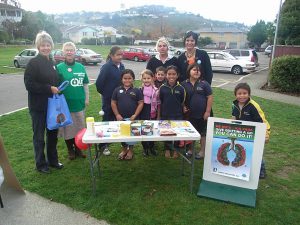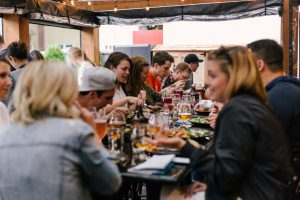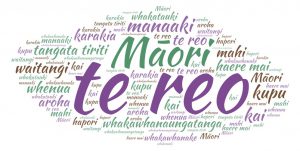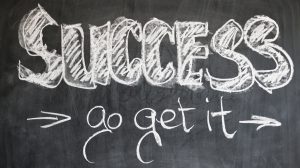Learning by Doing – a handbook
In 2013, Inspiring Communities published a comprehensive examination of community-led development. Appropriately named Learning by Doing, it includes both theory and practice, and is essential to anyone working in CLD in New Zealand.
Learning by Doing (LBD) includes comprehensive thinking, learning, examples and results from community-led activity right across Aotearoa. It’s become a ‘must have’ handbook for people and organisations wanting to empower and support locally-led change. Noticing change is at the foundation of effective change. CLD is a long term game, and one where rules, models and evidence only take us so far. We are constantly reminded that not everything that counts can be easily measured. So it’s important that we embrace a ‘learning by doing’ approach in order to better understand what works, what doesn’t and why. Sharing diverse examples, stories, ideas and results from community-led activity around Aotearoa serves to strengthen a community’s ability to succeed. These examples are intended to support and inspire you to use community-led development to make positive change in your place.
A number of the book’s chapters are also available to download and share:
See highlights from the launch of Learning by Doing at Te Papa here.
What others have said about Learning by Doing….
“This book is a fantastic resource for practitioners and policy makers. It both provides a collection of really useful tools and resources, and it shares “real life” stories of how people have made use of these in practice in New Zealand. I highly recommend it.” Liz Weaver, Head Coach Tamarack Institute of Community Engagement – Canada
“Learning by Doing is a gift to the nation and also to the international community-led development movement. Just when we need it most, here is a book guiding people back to the power of community.” Jim Diers, Neighbourhoods Expert- Seattle USA.
Deepen your knowledge by purchasing a copy of Learning by Doing
To purchase a copy please email exchange@inspiringcommunities.org.nz
Practical Steps to Growing a Community Vision
Building a community vision takes time and it’s something that just keeps growing. It will be renewed, refreshed and re-inspired over time, as issues and opportunities are addressed and new dreams grow.
1. Design a few powerful questions for getting community conversations started
Powerful questions: How to get community conversations started
How to craft powerful questions
2. Reach out to lots of different people in fun creative ways
All communities are different, so community engagement approaches need to be tailored for each context and culture – the why and the who strongly influences your how. Your why should determine both who you are engaging with and what/how things are set up.
Take a look at these ideas for community engagement.
3. Make the most of community conversation feedback
Learn how to make the most of your community feedback. Even though your community conversations might be informal, people want to know something is going to happen as a result. This resource will provide you with a systematic approach to determine whether the essential conditions for change are present and how to support and enhance those conditions for the better.
4. Run a community gathering
Once you have some initial feedback from community conversations it’s likely time to plan a community party or gathering to further shape your vision and grow wider connections. Check out our tips of organising a community planning hui .
Or on a smaller scale, getting together with your neighbours is one of the many things you might do to help build a sense of community in your street. Check out our Tips for organising a street BBQ.
See Our Reach Out resource for more ideas.
Community engagement tips
Reach out to a diversity of people, in fun creative ways to have lots of conversations
All communities are different, so community engagement approaches need to be tailored for each context and culture – the why and the who strongly influences your how. Your why or purpose should determine both who you are engaging with and what/how things are set up. What do you want to learn, share or achieve as a result of the interaction? Once you have your clear engagement purpose in mind, it’s important to do some background work to get prepared.
There is no one size fits all when it comes to engagement. Depending on your role, you might use a variety of methods to engage with diverse people and groups: for example, one on one or (small or large) group meetings, phone conversations, and online communications. Some will be formal meetings that may need preparation beforehand, e.g. developing agendas, making a presentation or organising an event.
Others will be smaller in scale, requiring a different style and level of formality, e.g. a scheduled café meeting or a brief conversation at a community hui to build relationships, exchange information and get to know what’s important to each party. Some may involve working with other partners in joint community engagement activities and could involve the creation of an engagement plan.
For getting started as a new community group or in a new place or role, here are some useful community engagement tips:
Make time to understand the local scene, who’s here and how things happen
- Do some googling
- Chat with neighbours, colleagues, others in the community you may know
- Attend community hui/workshops/meetings to get a sense of local people, place, and context Who are mana whenua? What about tangata whenua, taura here, mātāwaka and tauiwi relationships?
- Which key community leaders, organisations and networks will be useful to have on your radar?
Be positive, proactive and observant
Take every opportunity to meet new people and organisations. A friendly smile goes a long way! Also look for cues in terms of formality, style, tactics and different ways of engaging by watching and learning from other effective community leaders you meet.
Do what you say you’ll do
If you say you’ll follow up by phone next week or that you’ll forward information, do it, or let people know if something’s no longer possible. This shows respect and helps builds trust and confidence.
Relationship building between tāngata whenua and tāngata Tiriti
Relationship building between tāngata whenua and tāngata Tiriti (all others who have come here) organisations, groups and communities is a core component of CLD in Aotearoa. Here are some resources to support you in developing these relationships.
Here’s a resource on developing relationships with Tangata Whenua. Many of the key messages, for example in Atawhai Tibble’s 5 Wais of Māori Engagement (this can be read fully fleshed out in context here), also apply to engaging with communities more broadly.
Ideas for how to reach out
Community hui (meetings) are necessary but not enough to engage people around growing local visions and inspiring local action. Only some parts of the community will show up to meetings, for all sorts of reasons. So, we need to get creative about going to where people are and having lots of conversations. From those conversations, we can shape doable small actions to get started.
Once you are clear on your why (e.g. you know more about this community’s history, hopes and dreams) and have some ideas about what you want to ask, here are some creative examples about how to reach out, that have worked for others:
- Knock on doors street by street and have one-on-one conversations
- Invite people out into a suitable place on their street for a cuppa and a chat
- Use an artificial Christmas tree in a shopping area for people to add their wishes to and as a conversation starter
- Use PhotoVoice or a similar tool to engage people whose voices don’t always get heard
- Engage children in classroom discussion with art materials, props, stationery…
- Encourage the children to go home and talk to their parents about the same questions
- Invite people with disabilities, new migrants, older people and other groups commonly left out to help you design new ways to engage with them and their networks
- Plan a fun community event like a community dinner or family fun day and get people drawing, talking and building images of what they would like as part of the event
- Use existing connections to grow connections, e.g. finding out who has links with the local hapū or iwi and who are the appropriate people to start connections with
- Use a large map of the area as a focus point and discussion opener and ask Where do you live? before going into deeper conversation
Make sure you are inviting participation and sharing information about how people can be involved, not just collecting ideas for ‘someone else’ to action. People might decide to do something together straight away, or to share contact details. Otherwise, let them know how to stay connected.
If you are working with children, check out these fun, educational activities for primary and intermediate students on valuing, enjoying, improving and caring for one’s street, neighbourhood and community from the Ranui Massey Back to Back Project: A booklet for teachers and A booklet for students.
What can go wrong?
There are many things that can get in the way of positive community engagement, e.g. lack of time, transport, childcare or interest, people’s busy schedules, lack of experience or information, poor organisation or communication, a history of bad past experiences, leadership styles/attitudes/behaviours and the sheer fatigue of overcommitted people.
The best way to know how things are going and/or to understand why they are not going well is to intentionally and openly ask. You don’t have to be the expert. Rather, you can ask people from the groups you want to be more engaged about what you need to do differently. When inviting feedback and encouraging constructive dialogue around outcomes, barriers, possibilities, you need to be prepared to honestly and openly listen, reflect, clarify and identify potential changes that could be made. And ideally you will work with those same people to co-design and implement a new way forward. You can turn failure into stronger trust and respectful relationships for the future.
The use of images to communicate
PhotoVoice is a process that was developed in 1995 by Caroline Wang to gather information from women living in rural China. It’s an opportunity for community members who aren’t often heard, or find it hard to communicate, to talk about things that are important to them.
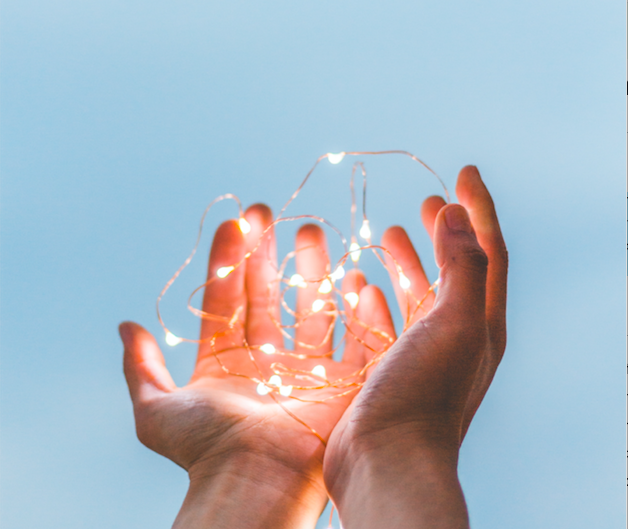
An opportunity for community members who aren’t often heard, or find it hard to communicate, to talk about things that are important to them.
VOICE stands for Voicing Our Individual and Collective Experiences.
Each PhotoVoice project is different, and how it’s facilitated will depend on who you’re planning to connect with, what you’re trying to achieve, and how many people will be in attendance. It will also depend on the individualities of participants and the community itself.
Learn more and visit the PhotoVoice website for more information.
How to craft powerful questions
Learn by doing
The types of questions we can ask, and the ways in which they’re asked, can have a big impact on how people engage with us and what information is received in return.
Asking well thought out, clear and direct questions is a great way to be more efficient in meetings, gather the information you know that you need, and getting the most from the people who have gathered to share information. If you’ve not done this sort of thing before it can be a challenging exercise, and we recommend that you take some time to work through this helpful worksheet.
If you would like to learn more about engaging your community, be sure to have a look at the page How to get community conversations started.
Active Listening Checklist
Active listening involves paying attention, withholding judgment, reflecting, clarifying, summarising and sharing. Each listening skill requires several techniques or behaviours. Download the PDF resource below to learn more.
How to get community conversations started
What do you need to know and why? Here are a few examples of powerful questions you might choose from or adapt. They are strengths-based and reflect an Appreciative Inquiry approach. They help us clarify our why – purpose or vision, what – actions people have energy for, and how – how people will work to draw on the strengths the community already has.
The kinds of questions you ask can have a big impact on the way people engage with you, the type of information you gather and on the involvement or action that follows. Strengths-based questions bring out community pride and help identify assets for addressing challenges. These questions invite conversations about community issues that need to be addressed, but don’t start by focusing on a problem or on something that’s missing.
Closed questions generally elicit yes/no responses. The more open-ended your question, the more powerful they are in triggering deeper conversations and encouraging people to think more creatively. As a result, new possibilities emerge and often provoke next questions.
We want to begin a conversation and grow a relationship. We want to gather information, but we are also building trust and together exploring possibilities for future engagement.
Examples of powerful questions
Choose a few questions to get community conversations started that are fit for your purpose.
What we already have
- What makes (name of our place) a great place to live, work and play in?
- What do we love about this place e.g. about its history, culture, physical/natural environment, people, facilities, etc?
- What’s happening?
- What matters to people?
- What is working well? And how?
- Who are key people helping make it a great place?
Our future aspirations
- What would make (name of our place) an even better place to live?
- How do we get more of the good stuff?
- What are your hopes and dreams for this place? E.g. if it was the coolest neighbourhood for you and your whānau/family to live, work and play in, what would it look like/be like?
- What needs to change? Why?
Making it happen
- If together we could take action on one thing to strengthen this place/community, what would be most important to you?
- What could we do?
- Two years from now, if we had been successful, what would you see?
- What opportunities do you see?
- What do people have energy for?
How will we do it?
- How would you like to be involved?
- What would you love to be part of?
- What’s important about how we work together?
- What are doable next steps?
- Who else in this space might be interested in helping us?
- How can we draw on what we already have here?
If you’d like to know more about designing your own powerful questions, see this resource on how to design your own powerful questions.
Other useful resources
Use the active listening checklist as a tool to help you or your group review what needs to be in place to have engaging conversations with the people you talk to, and check this tool to help you brainstorm ways to reach out to a diversity of people, in fun creative ways.
Here’s some further information about mapping community assets and strengths and Appreciative Inquiry as a strengths-based approach.
Te Reo resources
Te Reo Resources
Here are some useful resources, created for us, that we’d like to share with you. There are PDFs with karakia, waiata and whakatauki you can use. There are also accompanying sound files for these. Please feel free to use and share them.
We’ve also listed some websites and apps we think are great for learning Te Reo.
Downloadable PDFs
Sound files
Karakia
1. Mauri oho – Karakia timatanga
2. Whiti ora – Karakia timatanga
3. Whakataka te Hau – Karakia timatanga
4. Tukua te wairua kia rere – Karakia timatanga
5. Kia tau ngā manaakitanga – Karakia timatanga or whakamutunga
6. Unuhia – Karakia whakamutunga
7. Kia tau – Karakia whakamutunga
8. Whakapaingia ēnei kai – Karakia mō te kai
9. Kua horahia te kai – Karakia mō te kai
10. Nau mai e ngā hua – Karakia mō te kai
Whakatauki
Celebrating leadership
1. He kotuku rerenga tahi
Celebrating hard work
1. He rā whatiwhati kō
2. Tē tōia, tē haumatia
3. He Manawa tītī
4. Mauri tū, mauri ora
5. Kua hua te marama
How to add a Māori keyboard
See how to add a Māori keyboard and integrate it into Word with English here.
Useful websites and apps
Kupu
With the Kupu app, users simply take a picture. Kupu then uses image recognition to identify what the object is in the picture and provide Te Reo Māori translations for the object(s). Fun and easy to use!
Download here for iPhone users and here for Android users.
Pepeha
Pepeha is a way of introducing yourself in Māori. It tells people who you are by sharing your connections with the people and places that are important to you. Once you have completed your Pepeha you can save it to your device, have it printed for display or as a taonga for yourself or a loved one.
Top 10 Tips for Community-Led Development
Unfortunately, there is no simple recipe for Community-Led Development success. It’s more like raising kids than baking cookies! It’s a complex process and what works with one kid doesn’t always work with the next. Similarly, every community context is different. It takes time to understand each community’s diverse strengths, needs, challenges and dreams. Even when we grow a shared vision, there can be plenty of uncertainty about how to get there. There are no cookie-cutter solutions.
Lots of experimenting, learning by doing and adaptability is needed, by the people with the greatest knowledge of their own local community and the issues it faces.
Here are our Top 10 Tips for success in Community-Led Development.
Ngā Mātāpono/CLD Principles
Implementing all CLD principles at once is sometimes simply not possible, especially when you’re first starting out. What matters is starting from where you, your organisation or community are at and then applying a CLD framework to guide how things develop.
1. Grow from shared local visions
Learn about tāngata whenua, their history and aspirations
Understand who was in this place, who is in this place and who will be in this place.
Build plans with those who live, work, care, play, and invest in a place – the principle of te ahi kaa1.
Tailor-make solutions that reflect local ambitions, goals and contexts.
Grow a shared sense of optimism and collective ownership of the future.
2. Build from strengths
Everyone has a contribution to make.
Value residents as ‘experts’ in their place.
Proactively involve people who are frequently ignored.
Recognise the strengths tāngata whenua bring and build respectful relationships.
Value community assets. Use what you’ve got to help get what you want.
3. Work with diverse people and sectors
Foster connections between groups who don’t usually work together.
Support the aspirations of local whānau, hapū and iwi.
Ensure residents are actively involved in all aspects.
Build relationships between neighbours.
Encourage networking between community-led initiatives locally, regionally and nationally.
4. Grow collaborative local leadership
Seek leadership from across the community – everyone is a potential leader.
Value different cultural approaches to leadership.
Support local people who are doing things and connect them to others to grow their effectiveness.
Invest in developing skills and capacity of local leaders.
Celebrate local leaders and community achievements.
5. Learn by doing
Plan and work adaptively.
Build in time for structured reflection to understand what’s working and what’s not.
Use data and insights to measure impact. Document and share progress widely.
Embrace small steps that contribute to transformational change.
Use local practice-informed evidence to support system changes locally and nationally.
Download our five core principles in full – share these resources amongst your networks and CLD peers.


